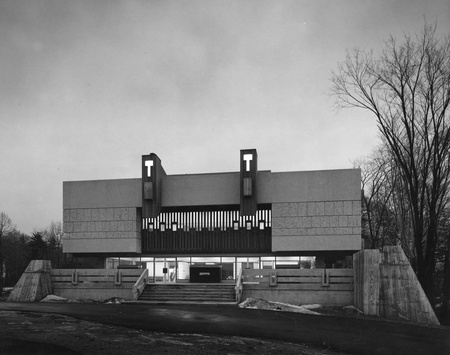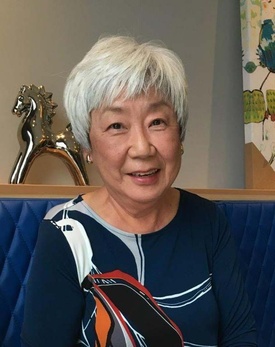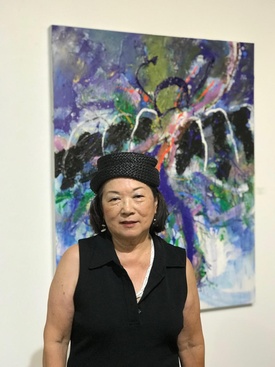Diana Morita Cole, Nelson, BC (born in Minidoka concentration camp)
One of my greatest pleasures is hiking the rugged Kootenay mountains where I live. Last fall, when I was climbing Baldface, an experienced hiker jabbed her pole into ground and asserted, “You people! You didn’t help us fight the Axis.”
In that moment, I knew there were greater obstacles to my journey than the mere crevices and boulders I would encounter in the trail ahead. “That’s not true, Nell.” I responded. “My cousin volunteered to fight just as his father was being hauled off to a detention centre in Tule Lake, California.”
Nell narrowed her green eyes as I went on to explain. “As for the Japanese Canadians in British Columbia, the provincial government banned them from military service to prevent them from gaining the right to vote under the Military Voters Act of 1917. Instead, able-bodied men were separated from their families and sent away to toil in labour camps. If they complained, they were locked up in POW camps.”
Nell’s colonial perceptions cannot remain unchallenged. Abandoning truth only results in greater evil, as we know from looking back on the crimes that were committed against the Japanese emigres to Canada, the United States, and Latin America during WWII.
Today, our personal narratives find resonance in the ethical values revealed in the magnificent building on Wynford Drive, which was designed as an act of consecration and a place of refuge for the Issei and Nisei, who were made to suffer in Canada. The original JCCC stands as a bulwark against the human follies of racism, intolerance, and forgetfulness. This was the meaning I perceived when, as a new Canadian, I first visited the JCCC in 1969.

The struggle now to preserve the aesthetic integrity of the first JCCC is part of the continuing odyssey to clarify who we are as a nation and what we want our country to become. Let us raise our voices against the proposed cultural appropriation of the original JCCC. Let’s commit our hearts and minds to the preservation of this unique historic landmark that tells us who we were and what values are uniquely ours.
M. Nakamura, Toronto
I’m casting my mind back to those years. I’m 60 this year, born in 1963, the year that the Japanese Canadian Cultural Centre was completed. It was so much a part of my growing up. Some families have cottage memories, while my childhood memories all revolve around the Centre. With Dad on the Board of Directors and Mom a member of the Women’s Auxiliary, our whole year was organised around the calendar of events at the Cultural Centre.
March brought the Spring Festival, and I saw volunteers on tall ladders stringing lanterns and Sakura cherry blossom decorations throughout the auditorium. There were Japanese dancing and performances, demonstrations of martial arts and kendo.
Then there was mochitsuki in the last week in April; pounding steaming hot rice until it was a dough and then quickly forming it into little cakes to cool outside, the ladies work so fast so as not to burn their hands.
The Annual Bazaar was in May, where at 1pm the doors opened and a rush of people came to find Noritake dishes, white elephant items, Japanese food, crafts, and gifts. It’s a rush of excitement as so much happens all at once.
Caravan in June brought the smell of deep-fried tempura and teriyaki chicken wings, the beer garden bustling and visiting Mayors and Princesses from other pavilions. Folk dancing to Tankobushi - everyone joined in!

Issei Day, to honour the first-generation Japanese Canadian seniors and preparing bento boxes with homemade Japanese delicacies. Walking around the auditorium serving hot green tea from big brass teapots to the Issei while they enjoy their meal and watch performances on stage. Artisan in the Fall would bring out the juried potters and artists, I still feel the comfort of holding a pottery teacup in my hands.
Fit between the annual events were all other weekly activities like Japanese dancing (odori) lessons, flower arranging (ikebana), calligraphy, kendo, judo, Japanese movie nights, and bingo fundraisers. The clubs and meetings were too numerous to count.
And I know I’m not the only one that remembers this. There were so many, many families that volunteered all year at the Centre. People who became our Centre Family. Friends who I called Auntie and Uncle although I wasn’t actually related to them. Everyone working so hard, until late, late at night when there were no cars left on the road, and no traffic to worry about as we drove back to Etobicoke.
It was a place for people to meet, to work together to make something for the community, to honour the Issei who first came to Canada; to celebrate the tides of the seasons, to really share our roots and culture with anyone who wanted to be a part of it.
I remember the feel of the woven tatami mats under my feet, in the judo room where no shoes were allowed. I remember the smooth pebbles embedded into the cement floor on either side of the auditorium doors along with the sound of rain, trickling down the heavy chains from the roof to the ground.
I can also recall the delicate plink into small pools of water amongst the stones with the heat in the kitchen; stoves working hard, steam from washing pans in the deep metal sink, and the back door left open to bring in a cool breeze. I remember the kimono clad dancers lining up backstage, their zori clicking up the stairs, while I peeked from behind the folds of the heavy purple velvet curtains. I felt the cool air as I ran down the wide staircase to the lower level, alcoves lining the hallway toward the kitchen… a perfect place to play hide and seek.
Then there was the upper level, wood slats elegantly hanging along the window, and low cushioned benches that were so comfortable to sit on. I am overwhelmed to have witnessed first hand what our parents did to keep the Centre running for the generations--past and future--and for the importance they placed on keeping it a Community Centre for all to use, balancing their Japanese heritage with the Canadian culture of their birth.
And I am grateful for Raymond Moriyama’s vision to create such a special place that pulled all of those pieces together. The JCCC was the most wonderful place to grow up, amongst friends and family. It was truly a Community Centre.
Barb Miiko Gravlin-Nishimura, Toronto (born in Tashme internment camp)
It would be shameful and irresponsible for the City of Toronto to approve for development the existing heritage sites - 123 Wynford Drive and the Ontario Science Centre in Don Mills. Both were brilliantly designed by award winning architect, Raymond Moriyama, who created these educational and spiritual structures that not only served the community but reflected and embraced the natural landscape. Once these heritage sites are demolished, wildlife and valuable green space within the city is lost and not to be recovered. Please make the ONLY choice, not bow to the powerful and wealthy. Moving the Science Centre to Ontario Place would make it less accessible to many children, students and schools to visit. Parking is already in chaos downtown with its stranglehold on drivers.
My first solo art exhibit was at the Japanese Canadian Cultural Centre, 123 Wynford Drive. Moriyama's unique building and space intrigued and inspired me e.g., the chains from the roof to the ground created musical drifts on rainy visits.
I hope you do the right thing and please save these heritage sites.
* * * * *
I was disturbed to come across the following when I did a Google search for 123 Wynford, which suggests that the outcome was already determined long before the February announcement:
Condo Project Summary
This new (48-storey) double tower condo development masterpiece is transforming an architectural landmark in North York.
123 Wynford Drive Condos is a new high-rise condominium by Originate Developments and Westdale Properties in North York. This pre-construction project is located at 123 Wynford Dr, just east of the Don Valley Parkway and north of Eglinton Ave in the Wynford-Concorde neighbourhood.
This development just steps from the Wynford Drive LRT station will be home to 1,128 residential units spread across two buildings. A selection of one-, two-, and three-bedroom suites will be available, with the Noor Cultural Centre located at the base of the second tower.
Clearly, it is indeed not a “perfect world” for Toronto’s Japanese Canadian community. It’s hard not to take a cynical view on how the grassroots community was not consulted on this important matter. How can anybody rationalise that the needs of Toronto’s JC community are being served by allowing the destruction of the one iconic JC building in Toronto that represents the hopes and dreams of our Issei and Nisei founders?
“This former JCCC is more than a shell to be disposed of when outgrown” says a Toronto chapter of the National Association of Japanese Canadians press release. “It symbolises the hopes and dreams of a community rebounding from harm and injustice. As a milestone it is distinct from its current location on Garamond Court. Ken Adachi wrote in the Enemy That Never Was that the JCCC was ‘First suggested in 1948 as a modest recreational and social centre, the concept broadened by 1953 into a ‘living memorial’ for the ‘pioneer issei.’”
Let’s hope the sacrifices that our Toronto JC Issei and Nisei pioneers made to create 123 Wynford Drive, our hallowed ground, will be appropriately honoured by something more than mere token gestures of reconciliation by the developer.
The founders of the Japanese Canadian Centre and all Japanese Canadians deserve much more than just that.
© 2023 Norm Ibuki








